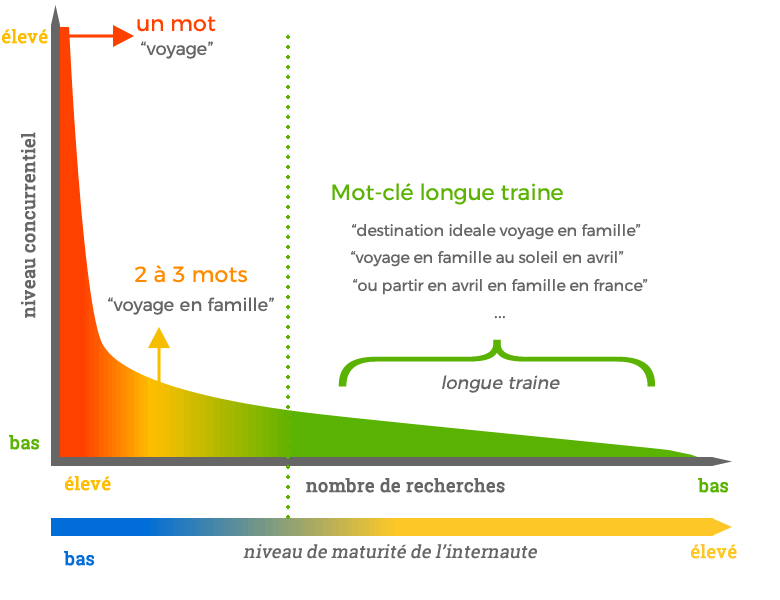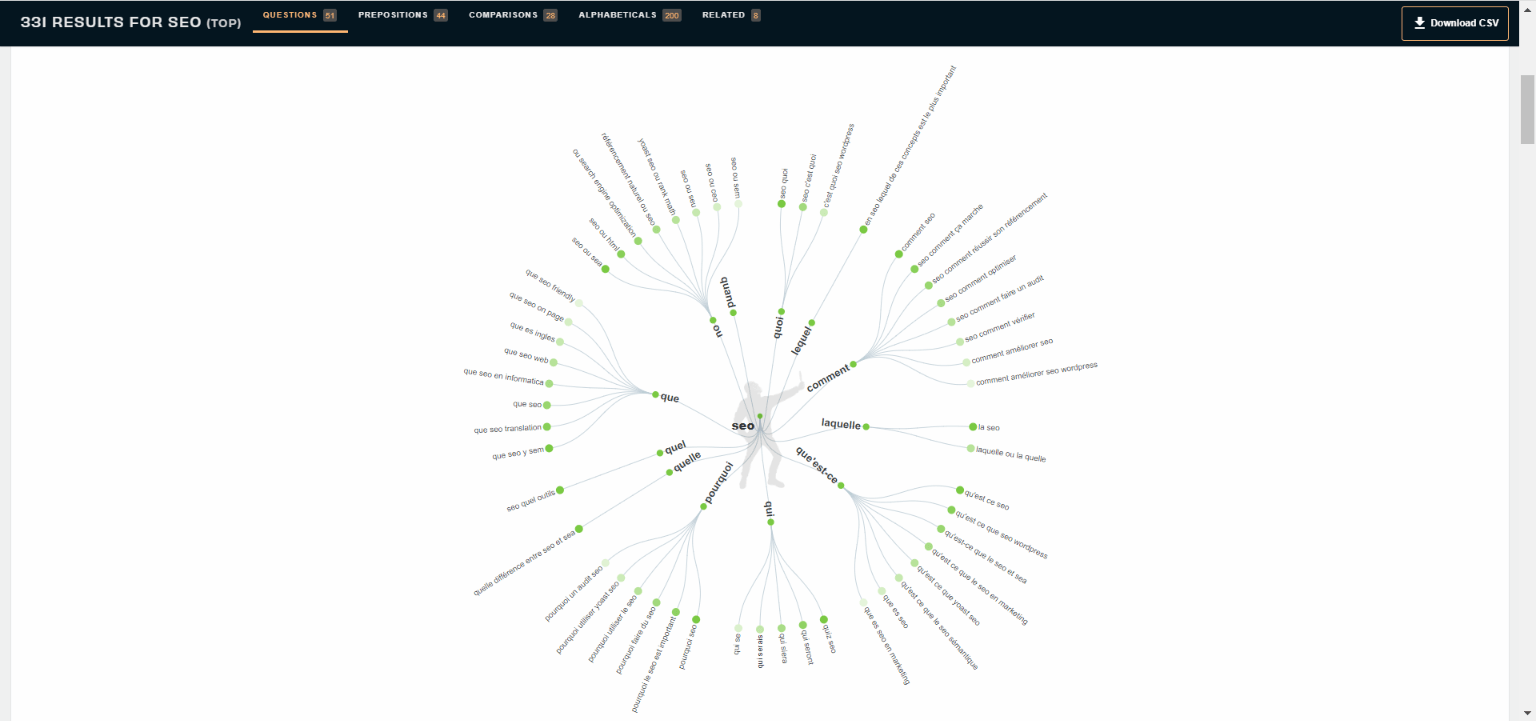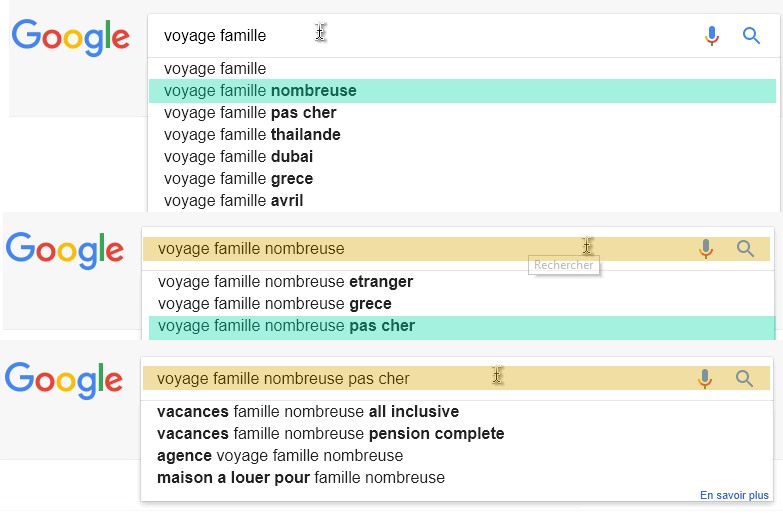I often get asked this question: **what are the new solutions for finding relevant keywords for my business? Today, more than half of internet users enter four words or more to find the right result on search engines. Also, note that nearly a third of Google queries are voice searches (and thus long-tail!). What are the consequences? If your keyword strategy does not target these terms, you are missing about half of your audience and half of your potential prospects. In short, a technique that allows you to multiply your organic traffic by 2 or 4 in a few months! Admit it, you dream of it!
🚀 Quick read: summary of necessary information on long-tail and qualified traffic
- Definition of a long-tail: an internet search equal to or greater than four words.
- Relationship between long-tail and qualified traffic: users who make long queries have a specific intent (qualified traffic!), which helps improve the conversion rate.
- Competitive advantage of a long-tail: competition on a generic keyword is much higher than on a set of keywords.
- How to find a long-tail: answerthepublic, Google (suggestions, other questions, related searches), blog comments, and forums.
- Prioritize long-tail keywords: search volume, SEO competition, and relevance.
- Work on the semantics around a long-tail: semantic variations, related variations, and overlap of search intents.
❓ What is long-tail SEO and why is it important?
Before we begin, here is a definition of long-tail ("long tail" in English):
- In organic search, long-tail keywords are search queries made up of four or more words (4+).

Long-tail keywords are used by users who know exactly what they are looking for. Indeed, they are ready to make a purchase or search for very specific information. Instead of searching for a generic keyword like "family trip," they search for "where to go with family in France in April" or "ideal family travel destinations." These are very different requests, but both seek very specific answers.
The advantage of long-tail keywords is that they are easier to rank. They are so specific that there is usually less competition in organic search rankings. This is an excellent opportunity to rank more easily in the SERP and reach a smaller but more qualified audience. This is concretely a ROI-focused content marketing strategy!
That's why you shouldn't miss out on the long-tail! Indeed, it represents an incomparable potential for you: attracting qualified traffic on 50% of keywords. If your keyword strategy does not include long-tails, it's time to start!
Attracting qualified traffic to your website can skyrocket your conversion rate!
1️⃣ Step 1: How to find long-tail keywords
The first step in integrating long-tail keywords into your content and SEO strategy is to compile a list of potential keywords to target. There are several sources that can be used to find a list of long-tail keywords:
- **Answerthepublic - This is a free tool that generates lists of long-tail keywords based on the general term you provide. The list is created by joining questions, prepositions, and letters to the keyword.

- Google Suggestions - When users enter queries, Google automatically tries to predict the rest of the query. These predictions are based on actual searches made by users. Try entering general keywords in the Google search bar to see if long-tail keywords appear in the suggested results. Then, search for even more by performing searches from the suggested results:

- Other questions - In the middle of the SERP, Google offers you questions to answer the search intent. Take advantage of this to find long-tail keywords and attract qualified traffic!

- Google Related Searches - When you perform a Google search, you will generally have access to a list of related searches at the bottom of the SERP.

- Forums and comments - Review the questions asked on forums, blog comments, or on Quora. Often, users of these systems ask questions because a web search did not provide the answers they were looking for.
For most of you, this exercise will result in hundreds of potentially relevant long-tails. But not all keywords will be worth targeting, and not all will require individual content.
2️⃣ Step 2: Prioritize the list of long-tail keywords to attract qualified traffic
To integrate long-tail keywords into your overall content strategy, you must first prioritize your list. To establish priorities, examine relevance, usage, and existing coverage:
- Find the monthly search volume for long-tail keywords using a tool like SemRush or Yooda Insight (more accurate for the French market). Phrases with higher search volumes may be more important to prioritize than those with "no data."
- Identify "medium-tail" keywords with little competition by performing searches in private browsing and reviewing the SERP results. Even low-volume keywords (also called "medium-tail" between 1,000 and 5,000 searches/month) can be prioritized if there is little competition.
- Make sure the keyword is relevant by performing a user intent search. Perform a keyword search and review the SERP. If your business sells slides and swings, for example, you might be surprised to learn that organic search results for "outdoor game idea" have more to do with products.
- Find the best keywords that have little content or could be improved and prioritize these keywords. By offering better quality or more comprehensive content, you could easily surpass the top results.
Keywords with a purchase intent and few searches may not generate significant traffic, but the traffic they generate will be highly qualified and more likely to convert. Conversely, low-volume keywords that do not show a purchase intent are certainly not a priority.
Once all the long-tail keywords have been prioritized, you can start creating optimized content for these keywords.
3️⃣ Step 3: Work on the long-tail through semantics
Although it may be tempting to simply write a content page for each long-tail keyword, this will create a mediocre user experience and likely yield no results. To get good results with long-tails, try creating comprehensive content using topic clusters.
Start by organizing your new list and group long-tail keywords by:
- Semantic variations - Gather keywords that essentially say the same thing, like "family trip in the sun in April" and "trip in the sun in April with family." Plurals and abbreviations should also be worked with the same keyword.
- Related variations - Keywords such as "where to go with family in France," "best family destinations in France," and "ideal French destinations for family vacations" are all related. Consider the who, what, where, when, why, and how of your topic.
- **Overlap of user intents - If multiple keywords generate very similar organic search results, it's probably because users are using them to find very similar results. You can, of course, use SEOQuantum to study user intent.
Look for long-tail keywords in the form of questions that require only short and simple answers. These keywords can be good candidates for an FAQ.
Now that you have grouped your queries, each family of keywords becomes a complete content element based on a main theme with a unique semantic universe. If you already have content targeting a broader keyword, improve it. Otherwise, write new web content. Use long-tail keywords to help you structure the content:
- Structure - Start with the most general term, and let the most popular and relevant long-tail keywords build the content structure. For example, create content "large family trip," and simply answer "What is...". The first subsection could answer, "the benefits of...," and the next could target "how to organize for...," "when to go...". The goal here is also to aim for position 0 (featured snippets) on Google Search.
- Content - Once the content is created, make sure you have used the long-tail keyword phrases in the strategic parts of the content without keyword stuffing. The use of keywords should always be as natural as possible and provide real added value.
When you're done, you'll have comprehensive content that will rank well for multiple long-tail keywords.
There are several advantages to including long-tail keyword research in an overall content strategy. Indeed, long-tails can be targeted to increase organic traffic and to answer users' questions very precisely. Moreover, you attract qualified traffic and thus improve your conversion rate.
Now, it's your turn to play! Start by searching for long-tail keywords and compile them into a list. Fill in an Excel sheet taking into account the long-tail keyword, its keyword group, its intent (see the SEOQuantum tool), its typology (see the tool as well), its search volume, and its competitive competition. Once that's done, review the list to see if it highlights gaps in your current content strategy.
And you, do you have any other long-tail optimization tips?
Need to go further?
If you need to delve deeper into the topic, the editorial team recommends the following 5 contents:





